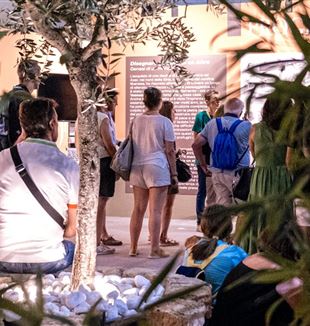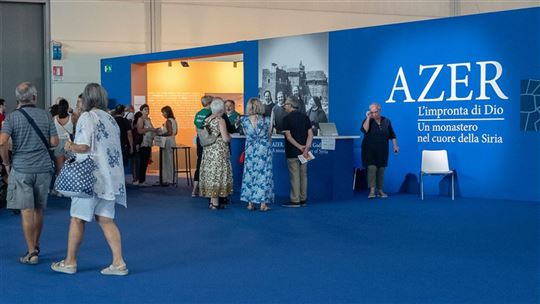
"Our work and the footprint of God"
They curated and explained the exhibition on the Trappist monastery of Azer, at the Rimini Meeting: the account of the preparation and the days lived by the volunteers who acted as "guides".I was the last to be involved by the organizers of this year's Meeting exhibition "Azer. The footprint of God. A monastery in the heart of Syria”, basically to write the texts for the panels and the catalogue. Meeting after meeting, reading after reading, I felt more and more provoked to leave room for something that surprised me, inviting me to look in a different way at what I thought I already knew enough about (the recent events in a tormented country, the coexistence of people of different faiths, monastic life, the Christian experience itself...), to tell the fascinating beauty of a reality I had encountered.
Thinking about the guided tours necessary for the Meeting, it was decided to involve about twenty friends from Varese as early as March. We did not just want to give them texts to study in advance, but to make them participants in the experience we were having.
After months of work, we received the great gift of Sister Marta Fagnani, the mother superior of Azer, who was present at the exhibition for the entire Meeting. Before Sister Marta left for Syria, we got together to say goodbye to her and talk about the experience. Everyone’s gratitude for what had happened was evident. This was also true for Sister Marta, as she repeated several times during the week referring to the guides: "I follow them; I learn more from my experience, listening to their story about me, a story that has become theirs!”
Paola rediscovered the convenience of saying a series of “yeses” (to a friend's proposal to go and work at the Meeting, to be a guide, to take part in the meeting, to study, to “take the plunge” with the guided tours...) because what she got in return was of an unimaginable density. The same happened to Cecilia, who was convinced that it was worth listening to the curators one evening on March 30. And Lucia, who, after telling her colleagues how she had spent her vacation – with her community and at the Meeting as a volunteer – saw a look of amazement and incredulity in their eyes, especially as she tried to describe the lived experience of "an embrace, in Christ, with joy, strength, hope, friendship", as Sister Marta wrote to her in the dedication of her catalogue.
For Anna, it was an encounter right from the start: "Not only during the Meeting, but also in preparing the exhibition, I realised that there was something great going on: in the experience that the curators were having, in the joy for the friendship born with these nuns; also in the desire to study the guides, not to miss a single detail that could make us and others understand more of their history". But what struck her most was to see how “the people who were there were themselves having an encounter, regardless of how good I was at explaining.” Chicca echoed her, saying that she had studied the content, but that it was as if this content was “overflowing from the eyes of those who arrived at the end of the exhibition, from those who came out repeatedly saying thank you, from those who stubbornly stood in the queue waiting, even though they had not booked.”
For Monica, too, what happened was first of all an encounter capable of making her see and feel that Christ is enough, as Sister Mariangela said with disarming simplicity at the end of the last video: "My joy is faith in Christ who loves me. Full stop". Monica added: "I have been working these days with lifelong friends, with some who are part of my Fraternity group. Something has changed among us: we are more certain, freer among ourselves, better friends, because it is clear to everyone that our friendship is in Christ, He is the source and the way for this inexhaustible friendship.”
Rosy's worries about being efficient were overtaken by the "desire to communicate the great encounter I had with Sister Marta and Azer. The only thing I cared about was being a conduit to make their presence known to everyone. At the end of the week, that was my exhibition and they were my sisters." Before Simona’s fateful ‘first’ guided tour, Sister Marta approached her and told her: “We are four misfits! If the good Lord has made all this around four little brats like us.... Who knows what He will do with this exhibition! Don't worry! That you said ‘yes’ is already everything! Everyone will come to see it. What has to happen, will happen.”
Those who, like Andrea, had the good fortune to meet the nuns of Azer in April were struck both by the communion between them – "a clear and fruitful friendship in Christ, an echo of that friendship that by grace I have encountered with the movement" – and by how the beauty of the relationship with Jesus generates a possibility of unity with all, whether Christians or Muslims. It was a fact that also surprised Fabrizia: “By putting Christ at the centre of their lives, the sisters of Azer can meet anyone who seeks the truth in their lives.”
The most precious thing that has remained alive in Angela's memory is the friendship between Alberto (the architect of the monastery) and Sister Marta, “the image of the two of them, on Sunday morning, walking side by side and talking to each other with an enviable intimacy of friendship.” She adds, “In the 13 years since the project began, many things have happened in Syria ¬– war, Covid, cholera, earthquake... – that have slowed down the work on the monastery. Yet it was also a time that allowed Alberto to 'convert' to friendship with Sister Marta and for us to welcome this friendship.”
"Following the method suggested by the editors, I began to read the transcript of the long dialogue between them and the sisters at Azer," another Simona pointed out. "I touched their stories with my own hands and saw in their eyes the hope in God's plan for all people, the peace and joy of abandonment to His initiative, the strength of humility of being instruments in His hands, and the profound unity of their lives, unlike the fretfulness that often fills my days.”
Read also - My Meeting with Charles and Dorothy
For Giorgio, during the days we lived intensely at the Meeting, "we felt we were answering, in our own small way, the most acute question of the exhibition: why waste resources to build a monastery in a destroyed land? And why did we 'waste' money, time, vacations to organize the exhibition and bring it to the Meeting? The answer seemed similar: for the sisters it is worth it to bring new people to Jesus through the monastery, to give others the experience that has changed their lives. We, in front of the shining eyes of thousands of visitors and in front of the true testimony of our nuns, can say the same thing: it was to give glory to Christ, but above all to live an experience of conversion ourselves, and for all those we met.”
I have also seen the faces of so many visitors change every day as they passed through the different spaces, more and more engrossed by an experience that, though discreet, imposed itself by its intimate truth and beauty: faces that were astonished, joyful, grateful. Watching Sister Marta in her tireless willingness to meet everyone, listening attentively to everyone, thanking and encouraging everyone, was an unforgettable sight. Surely all the richness of what happened did not depend on our abilities, skills or sensitivity, but on the grace of Another, who also ‘used’ us to make His mark on Azer's experience.
Marco, Varese, Italy